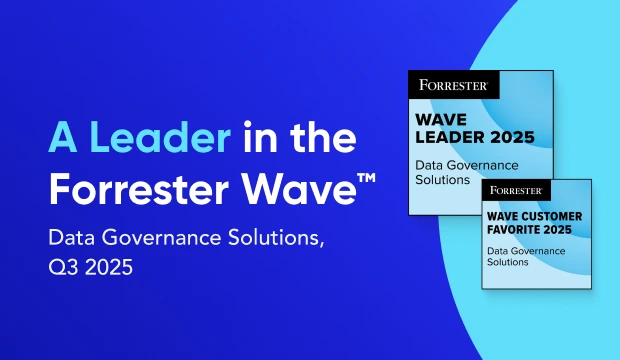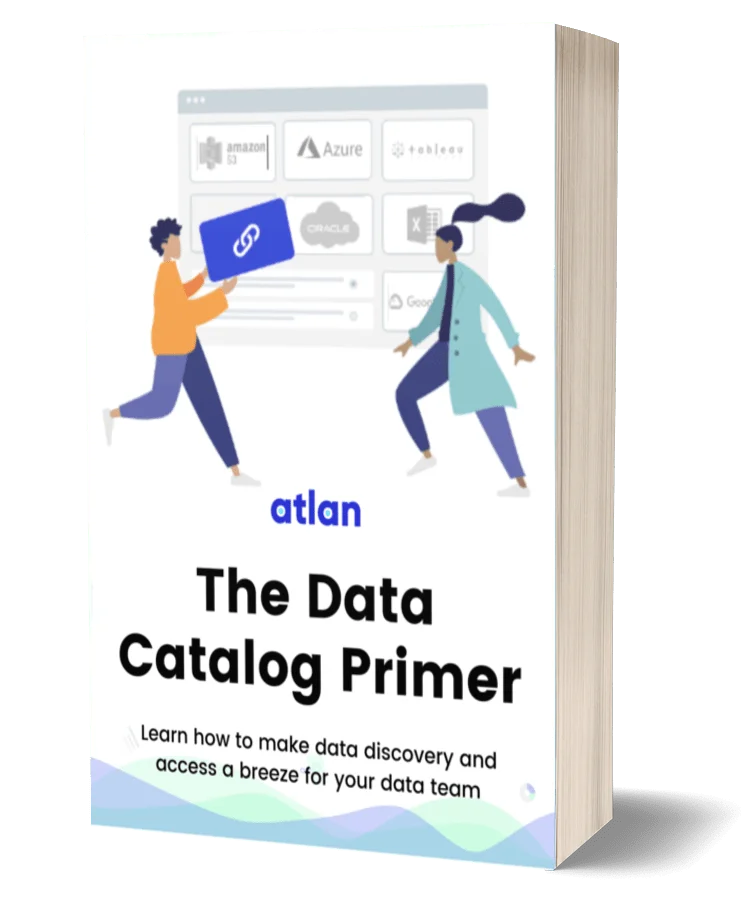Metadata Governance: Why You Shouldn't Neglect It

Share this article
Metadata governance is a sub-discipline of data governance that specifically focuses on the management, organization, and control of metadata. Implementing metadata governance ensures that your organization’s data is consistently managed, easily discoverable, and used correctly by your business teams.
As your business grows and expands, so will your data. But, how do you ensure your teams understand and make the best use of this data? The answer lies in metadata governance. We’ll explore more about it in this article.
Let’s go!
Table of contents #
- What is metadata governance and why does it matter: Unlocking the business benefits of better data management
- Beyond data management: Understanding the differences between metadata governance and data governance
- What is metadata governance framework & why is it key to ensuring data quality and efficiency?
- 10 Steps for effective metadata governance in your organization
- Key processes and checks to consider when evaluating metadata governance tools
- 6 Metadata governance challenges and how to overcome them
- Rounding it all up
- Metadata governance: Related reads
What is metadata governance and why does it matter: Unlocking the business benefits of better data management #
Metadata governance is the management and control of metadata in an organization. It involves establishing policies, processes, and procedures to ensure the accuracy, consistency, and integrity of metadata across an organization. It aims to define standards and guidelines for creating, documenting, and managing metadata to support data management and decision-making processes for better business outcomes.
In this section, we will learn the different benefits of metadata governance on your overall business outcomes:
1. Improved data quality #
By implementing metadata governance, you will have a better understanding of the context and meaning of your data. This will help ensure the accuracy, consistency, and completeness of your data, leading to improved data quality and more accurate analysis.
2. Faster decision-making #
Having well-governed metadata will make it easier for your employees to find, understand, and use the data they need. This will reduce the time spent on searching for and interpreting data, resulting in quicker, data-driven decision-making.
3. Increased collaboration #
Metadata governance promotes collaboration by ensuring that everyone in your organization has a shared understanding of your data. This shared understanding enables teams to work more effectively together and use data consistently across different projects.
4. Regulatory compliance #
As you lead the industry and define the data model for the EV charging network, you will likely need to comply with various data protection and privacy regulations. Metadata governance will help you manage and control your data, ensuring that you meet these regulatory requirements.
5. Monetizing data #
With a well-defined metadata governance framework in place, you will be better positioned to monetize your data. High-quality, well-documented data is more valuable to potential customers, partners, and other stakeholders. In addition, understanding the relationships between different data sets can help you identify new opportunities for monetization.
In summary, metadata governance is a crucial component of data governance that helps manage and control the context, meaning, and usage of your data.
Beyond data management: Understanding the differences between metadata governance and data governance #
Metadata governance and data governance are related but distinct concepts. While both are essential for effective data management, they focus on different aspects of the data lifecycle.
Data governance refers to the overall management of the availability, usability, integrity, and security of data within an organization. It involves the establishment of processes, policies, and standards to ensure that data is consistently and effectively managed, regardless of its format or source. Data governance encompasses a wide range of activities, such as data quality, data lineage, data cataloging, data stewardship, data security, and compliance.
Metadata governance, on the other hand, specifically focuses on the management, organization, and control of metadata, which is the data about data. Metadata provides contextual information about the primary data, such as data definitions, data lineage, relationships, and data quality rules. Metadata governance involves the creation, storage, and maintenance of metadata, ensuring that it is accurate, consistent, and easily discoverable.
In terms of action, the key differences between metadata governance and data governance have been summarized in this table:
| Aspect | Data Governance | Metadata Governance |
|---|---|---|
| Scope | A broader range of data management activities | Specifically focused on metadata management |
| Focus | Primary data management (availability, usability, integrity, and security) | Contextual information about primary data (data definitions, lineage, relationships, quality rules) |
| Processes & Policies | Data quality rules, data access controls, data stewardship responsibilities | Metadata standards, metadata cataloging, metadata lineage tracking |
| Tools & Technologies | Data integration, data quality, data cataloging, data security tools | Metadata repositories, metadata management platforms, data lineage tools |
In summary, while both data governance and metadata governance are essential for effective data management, they differ in scope, focus, processes, and tools used. Data governance is a broader concept that includes metadata governance as a sub-discipline, which specifically addresses the management of metadata.
In the next section, we will learn about metadata governance framework.
What is metadata governance framework & why is it key to ensuring data quality and efficiency? #
Metadata governance framework refers to the set of principles, policies, procedures, and metrics that an organization uses to ensure the efficient management, control, organization, and usage of its metadata. It forms an integral part of the broader data governance strategy of the organization and plays a crucial role in ensuring data quality, reliability, and accessibility.
It provides the structure that guides how metadata is created, stored, accessed, and utilized within an organization. Its primary objective is to ensure that metadata accurately describes the relevant data it represents, is accessible to all pertinent users, and is used correctly and consistently to inform decision-making processes.
It typically includes the following components:
- Metadata standards and guidelines
- Roles and responsibilities
- Metadata repository
- Processes and procedures
- Tools and technology
- Metrics and performance indicators
Let us look into each of the above components in detail:
1. Metadata standards and guidelines #
These are rules that determine how metadata should be structured and formatted. They define what metadata should be collected, how it should be classified and categorized, and the conventions for naming and describing it.
2. Roles and responsibilities #
Clearly defined roles and responsibilities ensure that every stakeholder knows what part they play in the metadata governance process. This includes defining who creates metadata, who maintains it, who can access it, and who makes decisions about it.
3. Metadata repository #
A metadata repository is a centralized database where metadata is stored and managed. The repository needs to be easily accessible to all relevant stakeholders and equipped with search capabilities that make it simple to find and retrieve specific metadata.
4. Processes and procedures #
These detail how metadata is created, updated, deleted, and managed over time. They also define how metadata quality is ensured through validation, how discrepancies are resolved, and how changes are logged and tracked.
5. Tools and technology #
This refers to the systems and software used to create, manage, and access metadata. The tools should support the metadata standards and processes established by the organization and be user-friendly for those who need to use them.
6. Metrics and performance indicators #
These help evaluate the effectiveness of metadata governance initiatives. They can include measures such as metadata accuracy, completeness, consistency, and the level of stakeholder engagement in the metadata governance process.
Implementing a metadata governance framework can yield numerous benefits, including increased data quality, more efficient business operations, and improved decision-making. It also ensures regulatory compliance and helps mitigate risks associated with data mismanagement.
However, a successful metadata governance initiative requires the involvement of stakeholders from across the organization, an understanding of the organization’s data landscape, and ongoing commitment to maintain and improve the framework.
10 Steps for effective metadata governance in your organization #
To ensure effective metadata governance in your organization, follow these steps:
1. Define your metadata governance goals #
Establish clear objectives for your metadata governance initiative. Align these goals with your overall data governance and business strategies.
2. Develop a metadata governance framework #
Create a framework that outlines the processes, roles, and responsibilities related to metadata management. This should include the following components:
- Metadata standards and definitions
- Metadata classification and categorization
- Metadata capture, storage, and maintenance processes
- Metadata quality and consistency requirements
- Metadata access and security controls
3. Assign roles and responsibilities #
Clearly define roles and responsibilities for metadata governance within your organization. This may include roles such as Metadata Stewards, Data Owners, and Data Governance Managers.
4. Choose the right tools and technologies #
Evaluate and select appropriate tools and technologies to support your metadata governance efforts. This may include metadata repositories, metadata management platforms, and data lineage tools.
5. Develop a metadata catalog #
Create a centralized metadata catalog that provides an easily accessible and searchable inventory of your organization’s metadata. This catalog should include information about data definitions, data lineage, relationships, and data quality rules.
6. Implement metadata capture and maintenance processes #
Establish processes to capture and maintain metadata consistently across your organization. This may involve manual entry, automated metadata extraction, or a combination of both.
7. Establish metadata quality and consistency checks #
Develop procedures to ensure the quality and consistency of your metadata. This may include periodic reviews, validation checks, and automated metadata quality monitoring.
8. Implement metadata access and security controls #
Establish controls to ensure that metadata is accessible only to authorized users and is protected from unauthorized access, tampering, or deletion.
9. Monitor and measure metadata governance effectiveness #
Define and track metrics to measure the effectiveness of your metadata governance efforts. Regularly review these metrics and adjust your processes and policies as needed to improve metadata governance.
10. Continuously improve metadata governance #
Encourage a culture of continuous improvement by regularly reviewing and updating your metadata governance framework, processes, and tools. Solicit feedback from stakeholders and adapt your approach to meet the evolving needs of your organization.
By following these steps, you can establish a strong foundation for metadata governance in your organization, ensuring that your metadata is consistently managed, easily discoverable, and used effectively across the organization.
Key processes and checks to consider when evaluating metadata governance tools #
When evaluating a tool for setting up metadata governance, consider the following processes and checks to ensure you select the right solution for your organization:
1. Identify your requirements #
Before evaluating any tool, define your organization’s specific metadata governance requirements. These may include metadata capture, storage, maintenance, quality, access, and security.
2. Review tool features and capabilities #
Assess the features and capabilities of each tool against your requirements. Key features to consider include:
- Metadata cataloging and search capabilities
- Metadata lineage and relationship tracking
- Metadata quality and consistency checks
- Integration with existing data sources and tools
- Support for various metadata types and standards
- Access controls and security features
- Scalability and performance
- Customizability and extensibility
3. Check vendor reputation and reliability #
Research the reputation and reliability of each vendor. Consider their track record, industry expertise, and customer testimonials. It’s important to choose a vendor with a strong history of providing effective metadata governance solutions and responsive customer support.
4. Evaluate the ease of implementation and integration #
Assess how easy it is to implement and integrate the tool into your existing data environment. Choose a tool that can be deployed quickly and seamlessly, minimizing disruption to your operations.
5. Assess the total cost of ownership (TCO) #
Consider the total cost of ownership of each tool, including licensing fees, implementation costs, ongoing maintenance, and support costs. Opt for a tool that offers the best balance of features and affordability to maximize your return on investment.
6. Request a product demo or trial #
Arrange a product demo or trial to get hands-on experience with the tool. This will help you assess its usability, features, and performance in a real-world context.
7. Evaluate vendor support and documentation #
Assess the quality of the vendor’s support services and documentation. Choose a vendor that offers comprehensive documentation, training resources, and responsive support to help you overcome any challenges during implementation and ongoing usage.
8. Consider future growth and scalability #
Evaluate the tool’s ability to scale with your organization’s growth and evolving metadata governance requirements. Choose a solution that can accommodate increasing data volumes, new data sources, and changing business needs.
9. Gather feedback from stakeholders #
Engage key stakeholders, including data owners, data stewards, and data governance managers, in the evaluation process. Gather their feedback to ensure that the chosen tool meets the needs of all users across the organization.
10. Perform a thorough risk assessment #
Assess any potential risks associated with the tool, such as security vulnerabilities, data privacy concerns, and vendor stability. Mitigate these risks through appropriate controls, or consider alternative solutions if necessary.
By following these processes and checks, you can systematically evaluate and select the right metadata governance tool for your organization, ensuring that it meets your specific requirements and supports your metadata governance goals.
6 Metadata governance challenges and how to overcome them #
Now, let us look at some of the main challenges organizations face in implementing metadata governance:
- Lack of understanding and awareness
- Difficulty in standardization
- Integration with Existing Systems
- Ensuring data privacy and security
- Sustaining stakeholder engagement and cooperation
- Scalability and adaptability of the framework
Let us understand each of the above challenges in detail:
Challenge 1: Lack of understanding and awareness #
Often, organizations fail to grasp the importance of metadata and the benefits that metadata governance can bring. This can lead to an underinvestment in resources for establishing a proper metadata governance framework.
Overcoming the challenge
Conducting educational programs and workshops can increase awareness and understanding of the significance of metadata governance. Leadership buy-in is critical; therefore, make sure to communicate the business value and potential ROI of a robust metadata governance program.
Challenge 2: Difficulty in standardization #
Creating uniform standards and guidelines for metadata across various departments can be challenging, especially in large organizations. This is due to the diversity of data sources, formats, and the varying needs of different business units.
Overcoming the challenge
A centrally governed approach can help in setting consistent metadata standards across the organization. Collaborate with different departments to understand their unique needs, and then create flexible guidelines that accommodate these requirements while maintaining overall consistency.
Challenge 3: Integration with existing systems #
Integrating the metadata governance framework with existing systems and technologies can be complex and time-consuming. If not done correctly, it can lead to inconsistent and unreliable metadata.
Overcoming the challenge
Choose metadata management tools that are compatible with your existing systems or have flexible APIs for easier integration. Invest in planning and testing phases to ensure smooth implementation and integration.
Challenge 4: Ensuring data privacy and security #
With the increasing focus on data privacy regulations, ensuring the privacy and security of metadata can be a significant challenge, especially if the metadata contains sensitive information.
Overcoming the challenge
Implement robust access controls to ensure only authorized personnel can access sensitive metadata. Regular audits and monitoring can help detect any unauthorized access. Compliance with regulations like GDPR, CCPA, and others should be a priority when setting up the metadata governance framework.
Challenge 5: Sustaining stakeholder engagement and cooperation #
Sustaining stakeholder engagement throughout the metadata governance journey can be challenging. Often, metadata governance initiatives fail due to lack of cooperation from different departments.
Overcoming the challenge
Promote a culture of data governance across the organization and involve stakeholders from the start. Regularly communicate the benefits and progress of the metadata governance initiative to keep stakeholders engaged.
Challenge 6: Scalability and adaptability of the framework #
The metadata governance framework needs to be scalable and adaptable to accommodate the growing volume of data and changing business needs.
Overcoming the challenge
Design the metadata governance framework with scalability in mind. Opt for solutions that are flexible and can be easily scaled up or down. Regularly review and update the framework to ensure it continues to meet your organization’s needs.
Rounding it all up #
Implementing metadata governance will support your business growth, improve data quality, enable faster decision-making, increase collaboration, ensure regulatory compliance, and ultimately, help you monetize your data.
While both data governance and metadata governance are essential for effective data management, they differ in scope, focus, processes, and tools used. Metadata governance is a crucial component of data governance that helps manage and control the context, meaning, and usage of your data.
Robust metadata management is the key for data-driven teams to discover, understand, trust, and collaborate on data assets across your data universe. If you are looking to implement a metadata management tool for your organization, do take Atlan for a spin.
Metadata governance: Related reads #
- Types of metadata: How each helps with faster data discovery and better insights
- What is the difference between data catalog and metadata management
- Metadata management 101: Benefits, tools, and best practices
- 6 metadata management best practices to follow in 2023
- What is metadata? : Examples, types, benefits, use cases, and why it’s so important?
- Data vs. Metadata : Understand the differences
- Enterprise metadata management and its importance in the modern data stack
- Mastering Business Metadata: How to Achieve Data Excellence and Streamlined Collaboration
- The Power of Metadata: A Guide to Effortless Data Discovery and Analysis
Share this article












